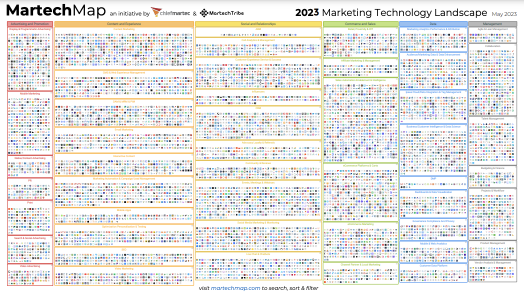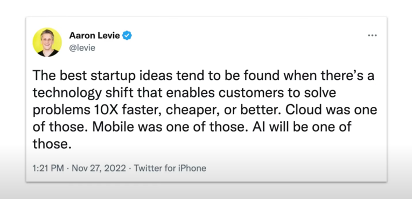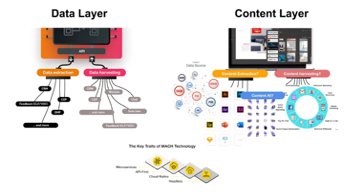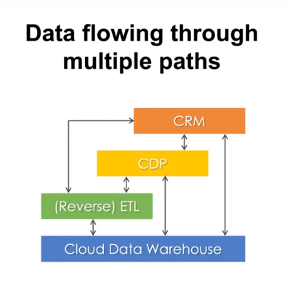Today (May 2) is MarTech Day. It’s also the day that the omniscient Scott Brinker of ChiefMarTech and the incomparable Frans Riemersma of MarTech Tribe issue their annual Marketing Technology Landscape supergraphic.
As today’s supergraphic reveals, Brinker and Riemersma’s 2023 MarTech trend predictions for a “highly fluid year” were spot on. As of today, there are 11,038 MarTech solutions – a net increase of ~1,100 from last year. In fact, there are almost as many new solutions this year as in the entire MarTech landscape in 2015, with even more innovation expected in the next 15 years.

Figure 1: Marketing Technology Landscape Supergraphic 2023.
While companies continue to find themselves spoiled for choice, knowing when and how to upgrade the MarTech stack can be a daunting task for any business leader. After all, it’s easy enough to put off a MarTech vendor search in favor of more time-sensitive business priorities.
Yet, in today’s rapidly evolving MarTech landscape, the best business leaders understand that an often-overlooked aspect of conducting a smooth and efficient vendor search is keeping abreast of the dominant forces at play in the broader MarTech landscape. Simply put, staying on top of relevant tech trends is a pre-requisite for making efficient, well-informed changes to the MarTech stack that will stand the test of time.
So, in recognition of #MarTechDay 2023, we’re sharing our take on the top 5 MarTech trends we think will define the rest of this year.
Trend #1: The best MarTech companies will become either atomizers or aggregators
From Riemersma’s perspective, there are two dominant high-level “forces” at play in the MarTech landscape today: atomization and aggregation. Thanks to the rise of MACH (microservices, API-first, could native, headless) architectures, companies are likely to evolve in a direction of either atomization or aggregation, not both.
Atomization refers to the growing popularity of single-use digital “tools” that do a single (usually smaller) task really well — these tools are often built by tinier, startup-esque organizations that aren’t bogged down by legacy tools or other types of internal constraints. Aggregation, on the other hand, refers to the types of tools that aim to connect, streamline, or integrate other tools, processes, or datasets within an organization. These tools are growing rapidly in popularity, thanks to the ever-increasing complexity of the MarTech stack.
As a CDP that plays exceptionally nicely with others, BlueConic ensures that any and all relevant customer data, no matter the source, is securely accessed and activated via our robust set of Connections and Listeners. In fact, core to a pure-play CDP’s function is the ability to make MarTech greater than the sum of its parts by providing a robust, up-to-date customer profile that is used to deliver the best customer experience.
Trend #2: “Productizing marketing” is here to stay, both within and across organizations
The rise of “productizing marketing” means that any process or project that is capable of being standardized will eventually become automated. Once automated, that process can then be turned into a “product” that is sold to or shared with others, either internally or externally.
At BlueConic, our customers are known to “productize” BlueConic features by selling services or reports that are generated by BlueConic’s CDP. A recent example of this productization is Endeavor Business Media’s CDP-powered Personif.ai offering,which enables advertisers to create meaningful interactions with readers across a vast media ecosystem by acting on insights from BlueConic Lifecycles. In just a few months, Personif.ai grew into a million-dollar-plus revenue stream for Endeavor Business Media, resulting in a 6.7X increase in revenue.
Trend #3: Generative AI will change the way marketers work
While machine learning AI has been used to enhance marketing workflows for years, generative AI is set to utterly transform the way marketing activities occur. This is “The Trend” that Brinker says is most likely to completely upend the way we work.
For example, imagine that your marketing team has, say, 700 micro-marketing personas and the tailored content to match every single one — that’s what the power of generative AI looks like. Adoption of AI/ML tech is projected to grow by 166% in the next 3 years.

Figure 2: Aaron Levie, American entrepreneuer & CEO of Box, shares how
confident he is that generative AI is true game-changer.
For those wondering why this AI revolution will bring about more change than ever before, it may be helpful to distinguish between ‘machine learning’ and ‘generative AI.’ Marketers have historically thought of AI as ‘machine learning’ tools that identify patterns within large amounts of data to suit specific purposes — e.g., segmenting prospects, identifying customer journeys, etc. However, as Brinker puts it, the “science fair projects have come to life” in the form of generative AI, which is AI that creates net-new content that will revolutionize how marketers market.
Generative AI is all about giving superpowers to marketers — particularly content marketers — in order to accelerate the production of everything from blog posts, landing pages, emails… you name it. Bonus: this tech can do light graphic design and video work, all while leveraging demographics, firmographics, psychographics, technographics, behavioral signals, engagement histories, and more to deliver content that speaks to individuals in an “empathetic,” human-centric manner.
Trend #4: Cloud data warehouses are having a resurgence
If you’re wondering how we get to a future full of hundreds of micro-personas, Brinker’s answer is clear: through the activation of cloud data warehouses, which are, in and of themselves, evolving from acting as static repositories to interactive components within the tech stack.

Figure 3: For Brinker, connecting customer data — ideally of the consented, first-party
variety, is an essential component of delivering on the promise of generative AI.
At present, there are a variety of tools (and combinations of tools) in the ecosystem — e.g., CRMs, CDPs, (reverse) ETL, etc. — that companies are using to activate data in cloud warehouses.

Figure 4: Cloud data warehouse activation isn't a one-size-fits-all operation.
When evaluating MarTech vendors, it's critical to determine which combination of
tools is best suited to meeting your organization’s business needs.
As companies consider the utility of their data warehouse – a few key considerations come to mind for using this data in 2023:
Is the data consented to and are there mechanisms in place to ensure only consented data is passed to the right tools?
What tradeoffs happen when data warehouses are used as the central source of truth? For example, is behavioral web data available as an input to real-time interaction?
Trend #5: Dichotomous approaches to growth are a thing of the past
Those who look beyond traditional, and unnecessarily dichotomous, approaches to organizational growth (e.g., suite vs best-of-breed; software vs services; build vs buy) will become tomorrow’s innovators. According to IBM research, companies who lean into a platform ecosystem strategy and operational approach are more likely to generate high levels of revenue and become market leaders than those who do not.
Brinker terms the emergence of this ‘ecosystem of partners’ strategy the “2nd age of MarTech,” and he acknowledges that there is a lot of room for innovation around what second-party data sharing can mean for partner relationships where marketing opportunities are concerned.

Figure 5: High-level distillation of how Brinker distinguishes between the
'1st age of MarTech' and the '2nd Age of MarTech'
Conclusion
All told, the most important thing to keep in mind when navigating the complex MarTech landscape in 2023 is to get informed and stay engaged. At BlueConic, the customers who see the quickest ROI are those they did their homeowork: our informed and engaged customers who have done the internal assessment work to determine which CDP is best suited to their needs or conducted critical change management processes are those who most consistently and reliably scale with their CDP, drive ROI, and transform existing business processes.
Interested in learning more about whether BlueConic’s CDP could transform your 2023 MarTech stack? Contact us here.






